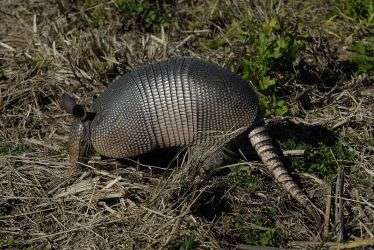Nine-banded armadillo: A model organism for vision disorders

Chris Emerling, a graduate student working with Prof. Mark S. Springer in the Department of Biology at the University of California, Riverside, gave a poster presentation on the nine-banded armadillo on Nov. 10 at Neuroscience 2013, the annual meeting of the Society for Neuroscience, held in San Diego, Calif. Emerling also participated in a press conference the next day.
In the presentation, Emerling and Springer propose that the nine-banded armadillo can be used as a model organism for achromatopsia and progressive cone dystrophy research. Both diseases involve the degeneration of cone cells in the retina of the eye, cells that normally contribute to the colorful, sharp images typically associated with vision.
"Those afflicted have completely colorless, low-resolution vision in the dark and blindness during the day, rendering their vision practically useless in most day-to-day activities," Emerling said.
Emerling and Springer examined the cone-specific genes of the nine-banded armadillo and discovered that these species completely lack cones.
"As a result, they can be used to search for new genes involved in these diseases, see how the condition progresses developmentally, and experimented on with gene replacement therapies, in hopes of further understanding and potentially finding cures," Emerling said.
Next, he and Springer plan on examining the genetic basis of vision in other species of armadillos, as well as their closest relatives, sloths and anteaters, to determine if their vision is equally degenerate.
"If verified, it would have major implications for their evolutionary history, behavior and would render these species as models for vision disorders as well," Emerling said.
Provided by University of California - Riverside